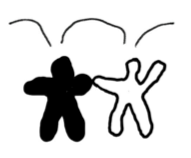Now Again in Performing Mobilities, Melbourne 2015
Video: Doug Donaldson
Olivia Millard, Peter Fraser, Shaun McLeod, Victor Renolds and Sophia Cowen
Performing the city through embodied experiences of responsive noticing.
Now Again is a participatory performance made up of a series of individual and group activities that create opportunities to notice how we fit and shift in our environment. Reflecting the dance histories of the artists, the variable dynamic possibilities of the city are brought into focus through specific ‘scores’ that, as propositions for engagement, activate simple movement patterns or observations. The aim is to allow responsive noticing of the immediate environment, but also to enliven it in unexpected ways. Individuals who are participants and observers, dedicated or incidental (passers-by), become part of the disclosure of the physical and the social.
The rigid structure of the city is re-imagined as a fluid, choreographic entity invested with organic qualities. Performances move between a series of city locations, each with differing activities. Designated ‘nodes’ in the city grid (certain streets, a square, a doorway, footpath, a hole in a wall or a particular tree), have been chosen for their imaginative, affective, or energetic resonances. These are ‘mapped’ by the perambulatory, physical, sensory, and relational engagement of all participants. This is a collective dance created through noticing the feelings and patterns of the physical self in the built, natural, and social environment.
In some sites, the artists perform, while in others they lead a participative performance. Ephemeral, self-led, performance experiments designed to disappear into the fabric of the city, will also be invited.
A mobile app enables audience participation. The app employs GPS data to trigger information specific to that site (written prompts, sounds and scored provocations).
Respondent text to Now Again by Sally Gardner:
The event Now Again evokes practices of walking and ‘walking in the city’. Walking practices remain for some a necessity for getting from A to B. There have been the romantic walking practices of sages and hermits seeking the sublime or for knowledge through contemplation in nature. Walking in the city has had numerous incarnations and subjects including the flâneur, a stroller and (non)participant observer. Alternatively, there was the man of the street depicted by Poe and Baudelaire who experienced the shocks of being jostled in the new urban crowds. Other walks and walkers have followed in the wake of ‘the society of the spectacle’ and have attempted to gesture to something outside its logic. These include Alan Kaprow’s practices of ‘just doing’ and the Situationist ‘traipses through Paris’ whose aim was to survey the city ‘for what might be salvaged and used in a utopian reconstruction of social space’.1 In Australia, walking has a particular resonance related to the Indigenous concept of ‘country’, ‘walking on country’, questions of legitimate/illegitimate sovereignty, and the right to feel at home or in place.
The event Now Again comes out of dance. More specifically, it comes out of a certain dance subculture, where basic physical activities and experiences such as transferring weight from one foot to another, ordinary balancing, touching, the whole field of accent experienced in the musicality of ordinary locomotions, leaving the ground as well as partnering with it, and shifting one’s axis away from the vertical, are all valued as fundamental practices. The attitude is of always being a beginner in one’s body and situation, of making sure to return to fundamentals over and over again, as in any oral tradition.
There is also a dance improvisational awareness in the decisions underpinning Now Again, if one understands dance improvisation in the tradition of what has been called ‘new dance’ – the somatically informed practices of various artists, many of whom can be related back in some way to Halprin, Forti, Paxton, and the milieu of contact improvisation with its focus on developing haptic awareness. Improvisation is a way of being present in the present moment, such that ‘your awareness of yourself within that moment both challenges and refines your presence in each subsequent moment’.2 The title Now Again refers to this perpetual condition of ‘now’ as a becoming present and as one’s unstable presence with, of and to the world. In keeping with this tradition, Now Again leaves a light footprint; and while it encourages an attention to the ‘here’, it does so by means of a relational or pathic rather than specular focus. The event’s route is guided by considerations of the everyday more than of the kinds of hidden or architecturally notable spaces of the RMIT campus and its CBD environs that might have been visited. Now Again is a group event. It structures a form of sociability – like parallel play. It accepts but does not demand communication.
1 Alice Kaplan, Alice and Kirstin Ross, ‘Introduction’, Everyday Life: Yale French Studies, no. 73, 1987, pp. 1–4.
2 Kent De Spain, ‘The Cutting Edge of Awareness: Reports from the Inside of Improvisation’ in Taken by Surprise: A Dance Improvisation Reader, Albright & Gere (eds), Wesleyan University Press, Middletown, Conn., 2003, pp. 27–38.
